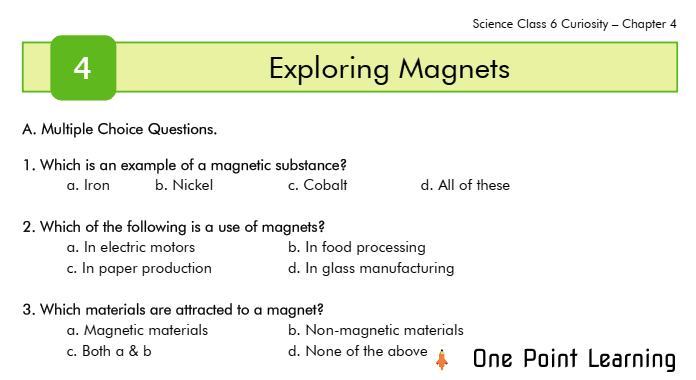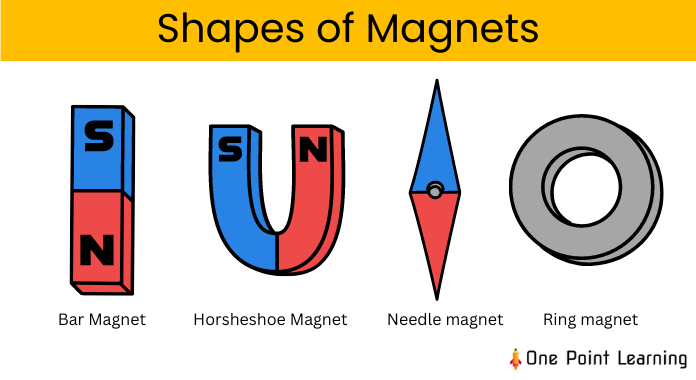In this Class 6 Science chapter 4 Exploring Magnets, we’ll embark on a journey to explore the properties, types, and uses of magnets. We’ll learn about magnetic fields, the difference between permanent and temporary magnets, and even create our own electromagnet!
Let’s find how a compass needle always points north? Or how a refrigerator magnet holds a note in place? The answer lies in the fascinating world of magnets.
Get ready to be amazed as we delve into the magnetic world around us.
- Introduction
- Types and Shapes of Magnets
- Properties of Magnets
- Experiments with Magnets
- Storing and Handling Magnets
- Magnetic Materials
- Uses of Magnets
- Earth’s Magnetism
- Electromagnets
Exploring Magnets Worksheet

Download our Chapter 4 worksheet today and unlock an amazing world of magnets.
Click to Join Us on WhatsApp Channel for latest updates!
Also download:
Class 6 Hindi Worksheet with Answers
Science Worksheets for Class 6
Exploring Magnets Notes
I. Introduction
Magnets: Objects that attract certain metals like iron, steel, nickel, and cobalt.
II. Types and Shapes of Magnets
- Natural magnets: Occur naturally (e.g., lodestone)
- Artificial magnets: Made by humans
- Permanent magnets: Retain their magnetism even after the magnetizing force is removed (e.g., bar magnets, horseshoe magnets, needle magnets)
- Temporary magnets: Lose their magnetism when the magnetizing force is removed (e.g., electromagnets)
Shapes:
- Bar magnets: Rectangular-shaped magnets
- Horseshoe magnets: U-shaped magnets
- Needle magnets: Small, needle-shaped magnets (used in compasses)
- Ring magnets: Circular-shaped magnets

III. Properties of Magnets
Two Poles: Every magnet has two poles – a north pole and a south pole.
Attraction and Repulsion:
- Like poles repel: Two north poles or two south poles will repel each other.
- Unlike poles attract: A north pole will attract a south pole and vice versa.
Magnetic Field: An invisible force field around a magnet that exerts a pulling or pushing force. You can visualize a magnetic field using iron filings.
IV. Experiments with Magnets
Simple experiments to demonstrate magnetic properties:
Attraction: Use a magnet to attract iron filings, paper clips, or other magnetic objects.
Repulsion: Bring two like poles of magnets together and observe them pushing away from each other.
Magnetic field: Place a sheet of paper over a bar magnet and sprinkle iron filings on it. The iron filings will arrange themselves in a pattern that shows the magnetic field lines.
V. Storing and Handling Magnets
- Storing magnets: To prevent them from losing their magnetism, store them in pairs with opposite poles facing each other.
- Handling magnets: Handle magnets with care to avoid breaking them or injuring yourself.

VI. Magnetic Materials
Types of Magnetic Materials:
- Ferromagnetic: Strongly attracted to magnets (e.g., iron, steel)
- Paramagnetic: Weakly attracted to magnets (e.g., aluminum, platinum)
- Diamagnetic: Weakly repelled by magnets (e.g., copper, water)
VII. Uses of Magnets
- Compasses: The needle of a compass is a magnet that aligns itself with the Earth’s magnetic field.
- Electric motors and generators: Magnets are used to convert electrical energy into mechanical energy and vice versa.
- Loudspeakers: Magnets are used to vibrate a diaphragm and produce sound.
- Magnetic Resonance Imaging (MRI): A medical imaging technique that uses strong magnets to create detailed images of the body.
- Magnetic levitation trains (Maglev trains): These trains use magnets to levitate above the tracks, reducing friction and allowing for high speeds.

VIII. Earth’s Magnetism
- The Earth acts like a giant magnet with a north and south magnetic pole.
- This magnetic field protects the Earth from harmful solar radiation.
- The Earth’s magnetic poles can shift over time, a phenomenon known as magnetic declination.
IX. Electromagnets
- Electromagnets: Temporary magnets created by winding a coil of wire around an iron core and passing an electric current through the wire.
- Strength of an electromagnet: The strength of an electromagnet depends on the number of turns in the coil, the strength of the current, and the type of iron core used.
- Uses of electromagnets: Electromagnets are used in various applications, including electric motors, generators, and magnetic cranes.
Chapter 4 Exploring Magnets MCQs
- Which is an example of a magnetic substance?
a. Iron b. Nickel c. Cobalt d. All of these - Which of the following is a use of magnets?
a. In electric motors b. In food processing
c. In paper production d. In glass manufacturing - Which materials are attracted to a magnet?
a. Magnetic materials b. Non-magnetic materials
c. Both a & b d. None of the above - What are the two poles of a magnet?
a. North and South b. East and West
c. Up and Down d. Left and Right - When a bar magnet is brought near iron dust, most of the dust sticks
a. Near the middle b. Equally everywhere
c. Near two ends d. At the middle and ends - What is a magnetic compass used for?
a. Finding directions b. Measuring weight
c. Telling time d. Measuring temperature - What kind of magnets were used by sailors in the olden days?
a. Artificial magnets b. Lodestones
c. Electromagnets d. Temporary magnets - Which shape of magnet is commonly used in a magnetic compass?
a. Bar magnet b. Ring magnet
c. Horseshoe magnet d. Needle-shaped magnet
Chapter 4 Exploring Magnets Question Answers
Que. What is a magnet?
Ans. A magnet is a material that has the property of attracting certain materials, such as iron, nickel, and cobalt.
Que. How can you identify the North pole and south pole of a magnet?
Ans. The north pole of a magnet is the end that points north when the magnet is freely suspended. The south pole points south.
Que. How many north poles and south poles would there be all if you break an into 20 pieces?
Ans. There would be 20 north poles and 20 south poles.
Que. Write three properties of a magnet.
Ans. Three properties of a magnet are: (1) it attracts certain materials, (2) it has two poles, and (3) it can be made to lose its magnetism.
Que. How can you make a simple compass at home?
Ans. To make a simple compass at home, you can float a needle on a piece of cork in a bowl of water. The needle will align itself with the north-south direction.



